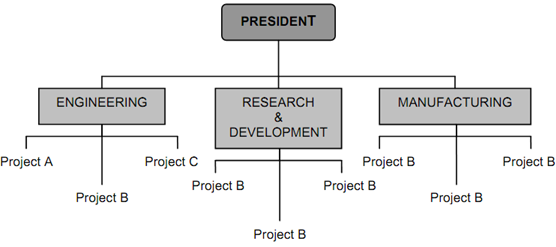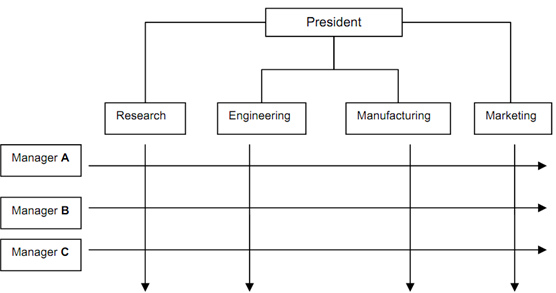Functional Project:
Functional project comprises the functional divisions. Figure illustrated the clear picture of underlying project. Its merits and demerits are:
Merits
- A team member may work on several projects.
- Technical expertise is maintained in the functional area even if individuals leave the project or organization.
- Team members continue regular functional jobs. Functional specialists can advance vertically.
- A decisive mass of specialized functional-area experts makes synergistic solutions to a project's technical problems.

Figure: Functional Project
- Project manager does not have authority over team fully.
- Motivation of team members is frequently weak.
- Needs of the client are secondary and are gradually responded.
In the matrix project, different projects borrow resources from functional area. It comprises the traits of functional and pure project structures both. An understandable picture of matrix project is shown in Figure with following advantages and disadvantages.

Figure: Matrix Project
a. Communication among functional divisions is enhanced.
b. A project manager is responsible for successful completion of the project.
c. Duplication of resources is minimized.
d. Team members have a functional "home" after project completion, so they are less worried regarding life-after-project than if they were a pure project organisation.
e. It permits efficient utilisation of resources.
f. Team members may communicate with project and functional managers.
Demerits
a. Team members contain a dual reporting relationship.
b. Conflicts regarding priorities may arise between managers.
c. It is doomed to failure unless the project managers have strong negotiating skills.
d. Sub-optimisation is dangerous, as project managers hoard resources for their own project.
A project starts out as a statement of work and objectives to be obtained along with their brief description. It also contains certain performance measures in terms of budgets, completion step, etc. In project management, the project is divided into meaningful tasks of shorter durations. A task or activity represents an identical unit of work that is carry out by a single individual or group of workers, with the apparent beginning and end. For instance, in constructing a house, the project is divided into task and sub-tasks such as making the house, painting, electric connection, etc. Once the tasks are described, the project manager decides the tasks that may be performed simultaneously, and that are performed in precedence of certain other tasks using project scheduling.